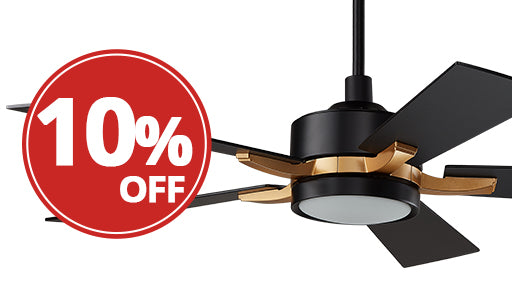There's nothing more frustrating than lying down in bed to snooze underneath your ceiling fan only to be disturbed by distracting and uncomfortable noises.
When was the last time you checked your ceiling fan? It's easy to dismiss ceiling fans as working fine, but like any other home appliance, ceiling fans need to be maintained for optimal performance.
Simple jobs such as replacing blades and ensuring the ceiling fan isn't shaking, wobbling, or squeaking is important to make sure it's working easily. After all, nobody wants to be disturbed by annoying noise, especially when they're trying to sleep.
If you need some advice on ceiling fan maintenance, we're here to help. Here are our tips on keeping your ceiling fan working at optimal efficiency.
Clean the Fan
A buildup of dust that gathers on your ceiling fan's blades can result in an imbalance between the weight of each blade. This leads to wobbling which can produce an exasperating noise.
Dust can also gather in the motor housing and motor, which can lead the fan to make another frustrating sound – squeaking.
To make sure your fan works at its best, be sure to clean it at least once a year. To clean it, first lay down a newspaper to catch any falling dirt or debris. Otherwise, you may be left with a big mess to tidy up afterward.
Then, make a solution of soapy water. Place a cleaning cloth into the soap solution, then use it to clean each blade of the ceiling fan. Wipe any sticky stains that may have developed over time.
Rinse the blades with another clean and damp cloth, then dry them with another clean cloth. You can also allow the fan to dry on its own.
Alternatively, many home equipment stores sell fan brushes specifically designed for this purpose.
You should also vacuum out the motor of the ceiling fan as dust can gather in it and cause the device to run slowly. Visit more about how to clean your ceiling fan.
Tighten All Screws
Ceiling fan maintenance also includes tightening all screws now and then. Ceiling fans are composed of different parts that are met together using screws. When a fan is on, it produces small vibrations that loosen some of those screws.
This can lead to the fan being noisy or shaky, which can be disruptive.
If you're wondering how to tighten a ceiling fan, use a screwdriver to pull the screws. If possible, concentrate on the fan, ceiling plate, and the light fixture.
Lubricate The Fan
If you've been wondering 'do ceiling fans need to be lubricated?' the answer is yes, many of them do. Many ceiling fans need regular lubrication to work efficiently.
To lubricate your fan, use a light oil to fill the oil hole that's found on the top side of the fan's motor. You can use oil that's similar to the oil used for a sewing machine.
For something more exact, you can choose a non-detergent 10, 15, or 20 weight electric motor oil. Look for one that's specifically designed for fans. You should avoid automotive motor oil and other oils that feature detergents that can be damaging for electric motors.
One to two ounces of oil should suffice, but a fan that hasn't been lubricated in a while may need more.
Fill the hole until the liquid flows over and then clean any excess oil away with a tissue or cloth.
If you're not sure if your fan requires oiling or how often, check the manual that came with it. The manual should give you directions on what type of oil to use and how to add it.
Likewise, if you can't find a hole to fil with oil, the motor probably doesn't need it.
To check if your motor requires oil, use a toothpick or a similar item. Place the toothpick ½ an inch deep into the hole and if it comes out dry, your fan requires oil.
Check For Movement
As part of your maintenance routine, you should also check your ceiling fan regularly for movements or shakes. Remember, the center of the fan shouldn't make any side movements while it's switched on. If it does, the fan must be rebalanced.
To rebalance your fan, you can use a fan balance kit.
You should know that a faulty blade may also make the fan shake or wobble. If your fan is moving strangely, check the blades to see if anything is missing or if anything's wrong.
Finally, you should check if any of the blades are bent or misshapen. To do this, take all the blades and put them on top of each other. If there are no issues, the blades should sit perfectly aligned on top of one another.
If there are any blades that are bent or misshapen, they will stand out when stacked upon one another. Visit more about how to fix the wobbly fan.
Ceiling Fan Maintenance to Practice
It's important to know that ceiling fans aren't supposed to operate on light dimmer switches. This is because either can result in the fan wobbling or wearing out more quickly than usual.
To avoid such issues, make sure you have the correct fan switch installed. A decent ceiling fan switch should feature an on and off switch, as well as a speed option.
With regular and efficient ceiling fan maintenance, your device should work well for a long time without any issues.
If you need to buy a new ceiling fan, we're here to help with our range of innovative smart options. Check out our bestsellers here.















